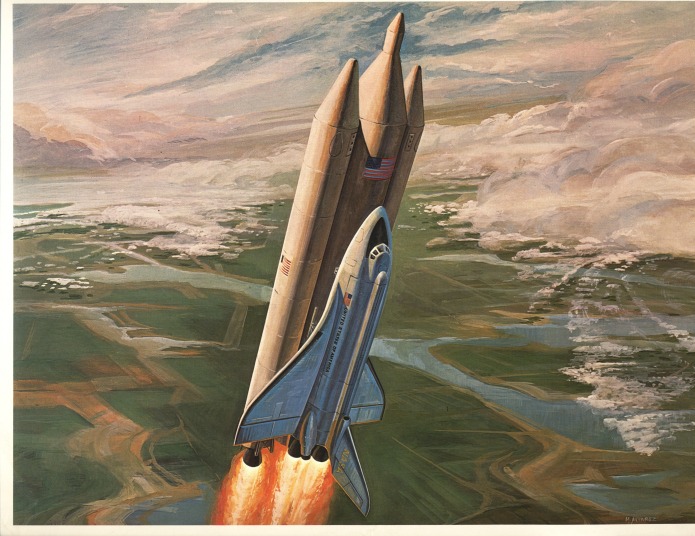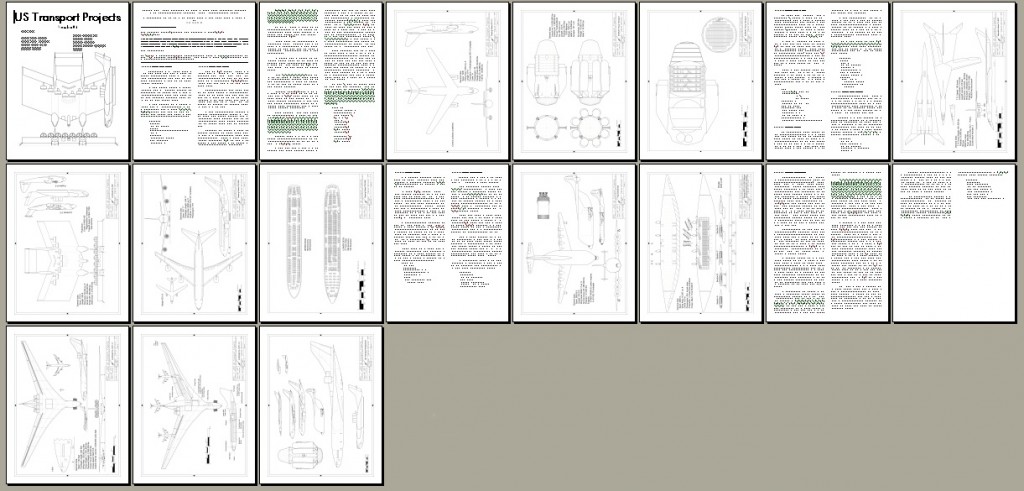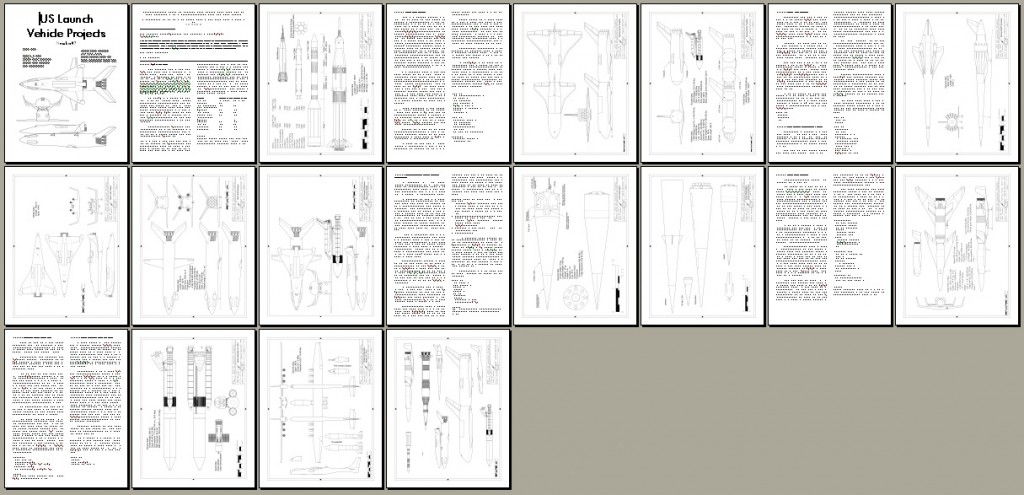Still, if you’ve got the bucks and the desire to cosplay… commitment to cause, man.
Rockwell art of an early Shuttle configuration. The full-rez version has been made available for $10-level patrons at the APR Patreon.
While this is broadly much like the STS as actually built, there are a lot of important differences. The spine down the top of the cargo bay… that was to give room for the cargo manipulator arm without putting it actually in the cylindrical bay, taking up valuable cargo space. The booster rockets have teardrop ports on the cylindrical sections just aft of the nosecones… these are the thrust termination ports that, in the event of an abort, would blow out through the forward dome of the rocket motors. This would not only slash the chamber pressure in the motors, it would provide an escape route for the hot gas to go forward, cancelling the thrust from the aft nozzle. The ET is of a slightly simpler geometry; the small cylinder on the nosecone contained the de-orbit solid rocket motor (because the ET would either go into orbit with the Shuttle, or so close to orbit that the splashdown location would be somewhat randomized).
I haven’t had an opportunity to really dig into this, but Boeing just patented a jet engine powered not by hydrocarbon fuel combustion but by small nuclear explosions. Basically an Orion (via laser-driven inertial confinement compression of tiny fusion fuel pellets) in a jet, stuck on a passenger plane.
Neato.
The US Patent Office page on this.
THIS should link directly to the PDF of the patent.
Sigh. Every single time I think I’ve got a handle on “this is everything in the world of NPP, I can finally finish the book,” they suck me back in
A number of folks noticed that something screwy happened with the Unwanted and APR blogs last night, intermittent failures to establish a database connection. Tech support was not particularly helpful (in fact,”I dunno” about sums it up). Might’ve been some sort of bot attack… something repeatedly downloading something or other and clogging up the works. Well, it *seems* to be back up and running now. We’ll see, I suppose.
But at the same time my pitiful little blog was going goofy, there were problems elsewhere:
Ladies and Gentlemen, It’s Time to Panic
Have you noticed anything odd going on this morning? Oh yes. Let us be the first to tell you that the time to panic is upon us.
ITEM: The New York City subway system suffered an atrocious commute today, with some trains being inexplicably stranded in stations for long periods of time.
ITEM: The website “The Dissolve” folded today.
ITEM: United Airlines was forced to ground all of its flights after its computer system mysteriously stopped working.
ITEM: The New York Stock Exchange suspended trading today after its computerized trading system mysteriously stopped working.
ITEM: Immediately after, the Wall Street Journal’s website mysteriously stopped working.
ITEM: More than 2,500 people in Washington, DC mysteriously lost power.
Hmmm. I choose to believe that it is the result of Plutonian hackers messing with us in rev3enge for taking pictures of them.
Now available… three new additions to the US Aerospace Projects series.
US Bomber Projects #15
USBP#15 includes:
- Bell D2001: A 1957 eight-engined Bell VTOL strike plane for the Navy
- Lockheed “Harvey”: AKA the Hopeless Diamond, Lockheeds first design for what became the F-117
- Convair Model 35: An early push-pull concept for the B-36
- Rockwell D661-27: A nuclear powered strategic bomber
- Boeing Model 464-49: The penultimate major design in the development of the B-52
- Boeing Model 988-123: A highly agile stealthy strike fighter
- Boeing Orbital Bomber: An early concept for a Dyna Soar derivative with eight nukes
- Boeing Model 701-251: A twin engined concept on the road to the XB-59
USBP#15 can be purchased for downloading for the low, low price of $4.
—
——————————————-
US Transport Projects #4
USTP#4 includes:
- Boeing Model 473-13: An early twin-engine jetliner
- ICARUS Troop Transport: 1,200 marines, anywhere, anytime
- Republic Model 10 SST: A little known SST competitor
- Lockheed CL-593: A giant, if slow, logistics transporter
- Boeing 763-059 NLA: A whole lotta passengers in one place
- Fairchild M-534: A B-36 converted into a vast cargo carrier
- Lockheed CL-1201: Probably the largest aircraft ever designed
- Oblique All-Wing Supersonic Airplane: A supersonic variable-orientation flying wing
USTP#4 can be purchased for downloading for the low, low price of $4.
—
——————————
US Launch Vehicle Projects #2
USLP#2 includes:
- Juno V, 4 stage: An early design that became the Saturn rocket
- Boeing “Space Freighter”: a giant two-stage spaceplane for launching solar power satellites
- Boeing NASP-D: A rare look at an operational National Aerospace Plane derivative
- LLNL Mockingbird: The smallest SSTO ever designed
- Boeing Model 922-101: A fully reusable Saturn V
- NAR Phase B Space Shuttle: a fully reusable two-stage concept
- Martin Marietta Inline SDV: A Shuttle-derived heavy lifter
- Scaled Composites Model 351: The Stratolaunch carrier aircraft
USLP#2 can be purchased for downloading for the low, low price of $4.
—
Footage of gameplay from the forthcoming “No Man’s Sky.” This is a “procedural” open universe… the game generates stars, planets, environments and critters on the spot, so there can be an incredibly large number of each (quintillions of unique planets are possible). You earn in-game money by flying around discovering new stuff. As it’s an online game, what you discover gets uploaded to an “atlas,” as does everything discovered by other folk, so the catalog of what and where will only get bigger.
Times like this I’m glad I don’t have a good computer hooked up to the internet, just a creaky old netbook. Because this sort of thing looks like it could suck me in and that’d be the end of me.
I graduated in 1995 with a degree in aerospace engineering, and promptly put that degree to good use: my first job was moving mufflers from one side of a warehouse to another. After about a week there, I got a call from a former classmate who had got himself an internship at NASA-Johnson; they wanted those of us who’d worked on a student design project for a moon probe to come and give a presentation. So I told my boss “I’m taking next week off.” When I got back they promptly fired me for ditching work… I wasn’t exactly tore up about that. When you’ve just been given a tour of the innards of a NASA facility, shuffling mufflers seems *really* depressing.
So, I buckled down and put my degree to use getting another job: moving items off one truck and onto another truck at a UPS depot. I was the one non-union, non-management guy there. It was my task to see to it that high-value packages ($5K and up) got off Truck A and onto Truck B, but due to union regs I wasn’t allowed to touch it; I had to beg a union worker to actually carry the package, which of course they did in their own time. A spectacular setup. Truly a model of efficiency.
Anyway, one day (*roughly* this time of summer, so right at 20 years ago) a result of a Freedom of Information Act Request showed up in the mail from NASA: the Summary volume of the General Atomic Project Orion report for NASA. It was a revelation! I took it to work with me one day and read through it on my lunch break (it’s not like I had to waste time socializing during lunch, since nobody would socialize with the one non-management, non-union guy), and a thought occurred to me:
“You know, I aught to take that $1.00 3D CAD program I just bought on floppy disk for my DOS computer and draw up the 10-meter Orion, and write an article describing the concept. I bet people might buy something like that.”
That was the first time it had occurred to me to take a stab at writing aerospace history in that format. I’ve been poking away at writing about Orion ever since.
So the NPP book has been in development for twenty years now. So based on that… how long do you think it’ll take to finish Pax Orionis? Hmmm…
A few things that might be of interest to all y’all investor types (note: I have no stake in these):
First Look At Axanar, The Star Trek War Movie We’ve Waited Decades For
“Axanar” looks like a fan-film on steroids. It hearkens back to ye olde FASA role playing game, so that’s kinda nostalgiatacular.
—————–
T-minus
T-minus is a thirty-minute, black-and-white film about Col. Benjamin Fletcher, a fictional member of the Mercury 7, America’s first men in space. The question at its core: Why risk one’s life in pursuit of the horizon?
This one is being shot on 35mm *film,* with all-practical effects, no CGI or greenscreens.
An old, old philosophical puzzler: at what point does damaging your *machine* become abuse?
Elvis apparently shot his TV at least once. Demolition derbies and action movies and 1980’s cop shows beat the hell out of cars for our amusement. Mythbusters dropped “Buster” the crash test dummy from cranes, set it on fire, blew it up. People put their smart phones in blenders just to see what’ll happen. And there are no perceived ethical problems with any of this.
But imagine a fully sentient humanoid android, capable of opinions and wants and dreams and feelings and such… C3-PO at the very least, or Data. Is it ok to abuse a mechanism like that just for giggles? Most, I trust, would think not. So at what point does “ok” become” dude, stop?”
It’s not, as I said, a new question. Mary Shelley raised the idea 200 years ago with “Frankenstein.” Frankensteins creature was not, as is generally portrayed, created by stitching together bits of corpses. He was, in fact, manufactured from the ground up. He was a truly artificial being. And the question was posed, what is the creators responsibilities to the creation? The question has been raised recently in movies like “Chappie” and (oddly) “Ted 2” and TV shows like “Humans” and “Almost Human.” But it was also – probably unintentionally – raised 31 years ago in the rather awful sci-fi “comedy” Ice Pirates. A bunch of robots are sent into combat and are all chewed up; but that’s not the scene in question. No, there’s a car chase on a city street. Three robots – rather typical early 80’s robots, barely mobile with little actual functionality – are crossing the street when a car comes along and plows into and destroys two of them. The third remaining robot starts spinning in a circle yelling “Mommy! Baby! Mommy! Baby!” We are left to assume that this was a family of robots, presumably a “husband,” “wife” and “child,” and the wife and child just got greased, leaving the husband in mourning. Ha! Ha! Boy, was that funny for 14 year old me, watching it on HBO. But within a few years, what was funny became instead really rather sad. Sure, they were just crappy props, but by imbuing them with the ability to mourn, even just in pretend, they became things is was *not* cool to just mash for chuckles.
And so, then there’s this:
Mr. Know-It-All: Is It OK to Kick a Robot?
Where we here about an experiment conducted a few years ago. A few groups of people were each given a “Pleo,” a toy robot dinosaur. They were also given craft supplies and told to dress up the robodino, and they held a “fashion show” for them. And then the people were told to “correct” the robodinos with corporal punishment, and people started to balk. And then the guy came out with the hatchet…
Here’s the thing: Pleos almost certainly had much less intelligence than a modern smart phone. The robodinos could dance around and put on a show of looking happy or sad, but there was no actual feeling there, just a few lines of code. You couldn’t have a conversation of even the lowest order with a Pleo. But with a smart phone, you *can* have a conversation of sorts with Siri. But if you decided to hammer your phone into tiny bits of metal, glass and plastic…. shrug.
At some point this question is going to be rather more than just purely academic. A basic rule of thumb I’d suggest is that a robot or computer is deserving of human rights when it, without being programmed or told to, asks for those rights for itself. But something doesn’t need to be legally human-equivalent to be deserving of protection from abuse. If I see you abusing a dog or a cat, chances are you might wind up with my boot up your ass, and dogs and cats don’t come anywhere near having human rights. So at what point will slamming your laptop bring the animal welfare officers to your door to lay a legal beatdown on you?
This makes for some interesting reading and analysis:






